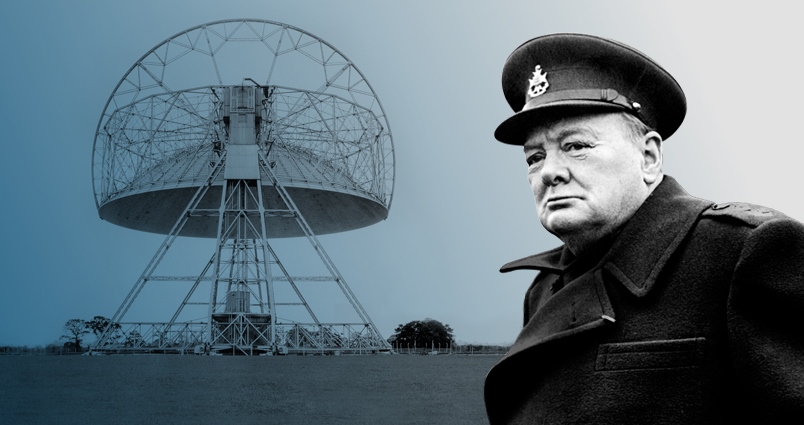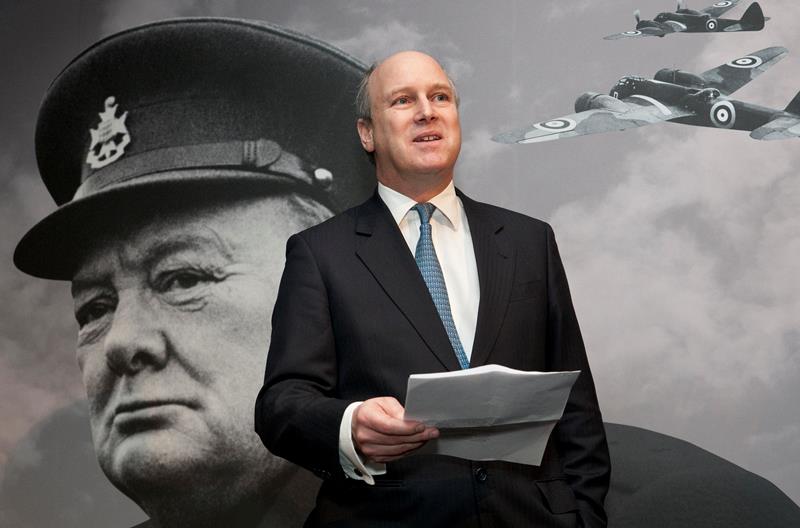Director of External Affairs, Roger Highfield, reflects on the recent discovery of an article written by Winston Churchill about the possibility of extra-terrestrial life
A remarkable glimpse of Churchill’s enduring fascination with science – expressed in a far sighted article he wrote in 1939 about the possibility of extra-terrestrial life – has been discovered.
In the article, Churchill had reasoned about alien life just ‘like a scientist’, comments Mario Livio, an astrophysicist in an article published in the journal Nature.
Livio had been shown the 11-page article, ‘Are We Alone in the Universe?’, by the Director of US National Churchill Museum in Fulton, Missouri, Timothy Riley, who had come across it in papers left to the museum by Emery Reeves, Churchill’s agent.
Science Museum Curator Emeritus Andrew Nahum, who curated the Churchill’s Scientists exhibition that opened in January 2015, decided to investigate a few days ago, when approached by the journal for comment, and found that there were two earlier versions of the typewritten essay in the Churchill Archives Centre at the University of Cambridge. “I wish we had found it ourselves in preparing for the exhibition,” he confesses.
The essay had been intended for publication in the News of the World newspaper, along with two others, and had been finished before he became Prime Minister. In the end only the latter two were published, and in another newspaper, the Sunday Dispatch, in 1942 (though it has since emerged that a shortened version of the alien life article did appear in the Sunday Dispatch on 8 March 1942)
For Nahum, Churchill’s interest in extra-terrestrials was “completely in line with his interest in science.” Aged 22, while on military service in India, Churchill had read Darwin’s On the Origin of Species, along with a primer on physics. Churchill also dabbled with leading-edge technology of the day, likely being the first politician to learn to fly.
Frederick Lindemann, the eminent physicist who became Churchill’s ‘on tap’ expert and was the first scientific adviser to a British Prime Minister, had once described Churchill as a ‘scientist who had missed his vocation’. While Chancellor, Churchill joked with Lindemann he had wasted a day reading a new popular book on quantum physics instead of working on the Budget.
In the 11-page article found by Riley, with the title ‘Are We Alone in the Universe?’, Churchill discusses the search for extra-terrestrial life.
A cast-iron definition of life remains elusive even today but Churchill made a stab by defining the most important characteristic as the ability to ‘breed and multiply’. After noting that viruses multiply but are hard to categorize as living things, he focuses on ‘comparatively highly organised life’, presumably ranging from bacteria to multi-cellular life.
Making a point that would chime with the agenda of the European Space Agency and NASA today, Churchill writes that ‘every living unit….consists to a very considerable extent’ of water. Churchill then defines what is known today as the ‘Goldilocks’ zone around a star that is potentially habitable, being neither too cold nor too hot, so that liquid water may be present.
He explains how a planet’s temperature depends on its distance from its local star, in our case the Sun, and also points out that its size, and thus gravity, influences its ability to retain atmosphere and water.
Taking these factors together, Churchill speculates that Mars and Venus are the only other places in the Solar System that could harbour life, ruling out recently discovered Pluto for example.
He talks about how changes in the colour of Mars ‘seem to indicate that some form of vegetation – be it only lichen – enlivened the faintly sunlit landscape’. And Venus, with its ‘hothouse atmosphere’ may harbour ‘intellectual beings’ that are unaware of the cosmos unless ‘they have developed some form of aeroplane.’
Decades before the launch of Yuri Gagarin in 1961, he adds that ‘it is conceivable that one day, possibly even in the not very distant future, it may be possible to travel to the moon or even to Venus or Mars.’
He goes on to say that ‘the sun is merely one star in our galaxy, which contains several thousand millions of others’.
Inspired by the discovery of Riley and Livio, Nahum investigated and believes that Churchill must have read The Mysterious Universe (1930) by astrophysicist Sir James Jeans because Churchill mentions the mechanism of planet formation suggested by Jeans: a near-miss of a ‘vagrant star’ with our Sun which tore off gas which then condensed into ‘a series of planets.’
Jeans also speculates in the book about how ‘there are millions of stars in the sky each similar to our sun, and each doubtlessly surrounded, like our sun, by a family of planets on which life may be kept in being by the light and heat received from its sun (p8)’-a speculation which Churchill also echoes.
The Jeans mechanism for planet formation may be rare, which would mean our Solar System may be ‘possibly unique’ and Churchill adds that ‘this speculation depends upon the hypothesis that planets were formed in this way.’
‘Perhaps they were not. We know there are millions of double stars, and if they could be formed, why not planetary systems?’ Thus, he says, ‘I am not sufficiently conceited to think that my sun is the only one with a family of planets.’
Given the immensity of the cosmos, a large fraction of planets that orbit alien stars ‘will be the right size to keep on their surface water and possibly an atmosphere of some sort’ and some will be ‘at the proper distance from their parent sun to maintain a suitable temperature’.This is a remarkably prescient comment given the hundreds of exo-planets -planets orbiting alien stars – that have been discovered in recent years, notably by the Kepler Space Observatory.
The essay finishes with Churchill declaring that ‘I, for one, am not so immensely impressed by the success we are making of our civilization here that I am prepared to think we are the only spot in this immense universe which contains living, thinking creatures, or that we are the highest type of mental and physical development which has ever appeared in the vast compass of space and time.’
It is telling that Churchill began his essay not long after the public alarm caused by the 1938 broadcast of the radio drama The War of The Worlds in America, an adaptation of the 1898 story by H. G. Wells, who became a friend and whom Churchill regarded as ‘a seer’.
‘Science isn’t a word most people associate with my great-grandfather’ commented Randolph Churchill, at the launch of the Science Museum exhibition, Churchill’s Scientists. However, he went on to explain how his great-grandfather had been fascinated with science from a young age.
Randolph Churchill also cited a prescient 1924 essay asking readers ‘Shall We All Commit Suicide?’ by his great grandfather that speculates about ‘a bomb no bigger than an orange’ with ‘the secret power to destroy a whole block of buildings – nay to concentrate the force of a thousand tons of cordite and blast a township at a stroke’.
As Graham Farmelo, former Science Museum Executive, makes clear in his book Churchill’s Bomb, no other national leader in the second world war had as much knowledge and understanding of modern physics in general, notably quantum mechanics, and the bomb in particular.

